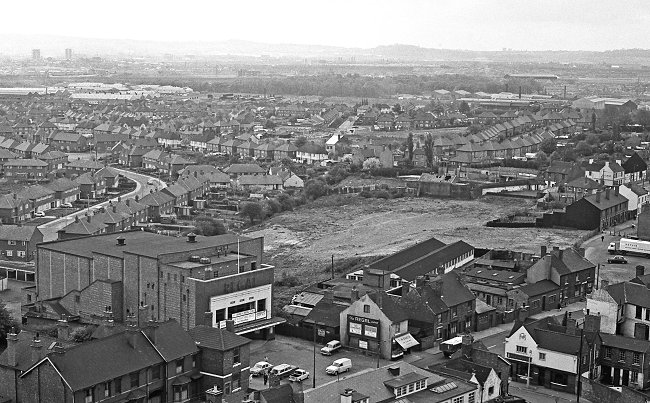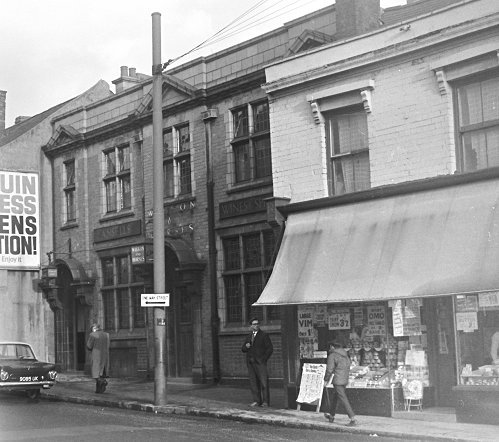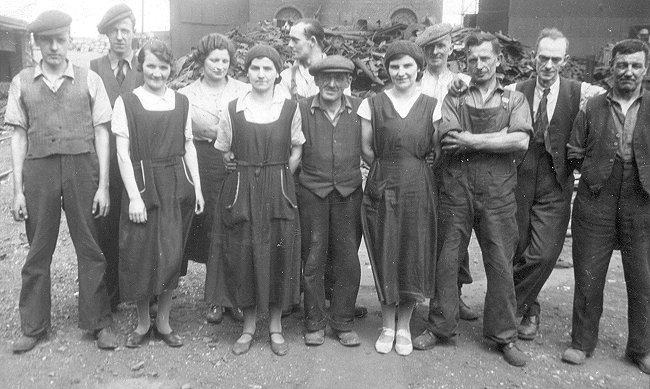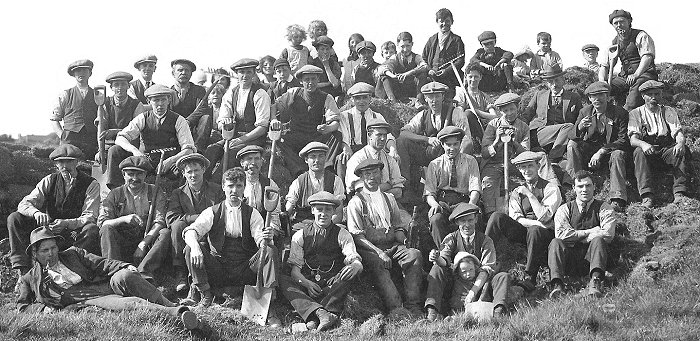|
Town built on coal and
the skill of gunmakers
As if standing guard, a line of hills stretches
across the south of the Black Country, dominating the
landscape. Rising up just below Wolverhampton, they line
up in a south-easterly fashion, beginning with Sedgley
Beacon and moving on through Wren’s Nest and Dudley
Castle Hill to the Rowley Hills.
The high ground then marches
onward, although more narrowly and less pronounced, out
of the Black Country and across Quinton and Frankley
Beeches, going on to merge with the ridges of Clent and
Lickey.
Important for their limestone and
road metal, these hills were vital to the industrial
development of the Black Country and they lie on the
watershed of England. To the west, water drains to the
River Severn via the Smestow and Stour system; while to
the east the River Tame and its small tributaries flow
away to the River Trent and the North Sea.
World renowned for their geology
and fossils, these hills provide a magnificent vantage
point for the South Staffordshire Plateau. Standing up
on Kates Hill at night and looking north-eastwards, down
at the valley of the River Tame, the darkness is picked
out by a multitude of lights from countless homes and
factories in an almost magical illumination.
Attracted
In the daylight, it is clear that
this low-lying ground is broken up by low hills formed
in most cases by glacial drift and which have not been
eroded by streams. From early times, these hills in the
basin of the upper Tame attracted settlers, but the
names that we call them today are those given them by
the Angles who moved in to what is now the West Midlands
in the late sixth and seventh centuries.
There's Bilston, mentioned in Lady
Wulfrun's charter of 985 and a few years later in 996
when it was given as Bilsetnatun, meaning the farmstead
or estate - tun - of the dwellers on the sharp ridge -
bill saete.
Then there's Wednesbury, bringing
to mind Woden, the greatest of the old pagan gods, who
was the creator, the god of victory and of the dead and
who is also remembered in Wednesday. Signifying the
stronghold - burgh - of Woden, Wednesbury may not have
been mentioned in documents until the Domesday Book of
1086 but its name indicates a much older origin.
Lying between these two is another
hill settlement, that of Darlaston. Just over a mile
north west of Wednesbury and three miles south west of
Walsall, it is also unnamed in the unprecedented and
massive gathering of information ordered by William the
Conqueror - unlike the other Darlaston in Staffordshire
near to Stone.
|

A mid 1960s view from the top of
John Wootton House looking across Darlaston to Dudley
and the distant hills. Courtesy of Bill Beddow. |
|
Mind you, that is not to say that
there was no Darlaston in the aftermath of the Norman
Conquest. It may have been included within a bigger
manor, such as that of Sedgley, or a scribe may have
missed it out by mistake. We don't know. What we can say
is that Darlaston signifies the estate (tun) of Deorlaf.
The earliest document for the place
named it as Derlaveston in 1262, although by 1316 its
modern form had emerged when it was recorded as
Derlaston. According to Sampson Erdeswicke, whose
pioneering and unpublished survey of Staffordshire was
carried out over the decade from 1593, a William of
Darlaston was lord of the manor at about the time of
Henry III, who reigned for much of the thirteenth
century. In 1801, the Reverend Stebbing Shaw brought out
an indispensable tome on the History and Antiquities of
Staffordshire, drawing on the work of Erdeswicke and
others. Fortunately he brought to light a little more
information on the history of Darlaston.
Dwelling
The first deed that he mentioned
related to Thomas lord of Darlaston transferring to Hugh
son of John de Bylestone a messuage (a dwelling house
and its surrounding property, including outbuildings)
formerly held by Amice le Peynnereste. Shaw thought that
this document also came from the reign of Henry III, and
in another deed he noted that a wood belonging to a
William de Darlaston had been destroyed of old. The
direct line of the Darlastons later died out and for a
time their old possession came into the hands of Henry
VIII when it was valued at 13 pounds nine shillings and
thruppence farthing.
Still, despite Shaw's researches,
there is little hard information about Darlaston and its
history. In Robert Plot's Natural History of
Staffordshire in 1686 it merited but a handful of
references. One related to the local iron ore which
could be made into nails, while another praised the
generosity of a Dr. Thomas Pye. Born in Darlaston, he was educated at Oxford and became a
vicar, teacher and writer in Sussex who was noted for
his learning.
In 1606, Pye visited "some
Relations at Darlaston near Wednesbury, upon occasion
that some of his Servants going to ring in the old
Steeple which was of wood and weak, had been in
danger of their lives". Accordingly, Pye offered to pay
for a tower of stone for the parish church of St.
Lawrence so long as the people of the "town" paid for
its transport. This they did and also put up an
inscription to his good-heartedness and piety.
Such references to Darlaston are
rare. Too often it was overlooked by commentators or
else it was associated with Wednesbury and given no
clear identity of its own. However, in 1698, good coal
mines were pointed out at Darlaston. It is not
surprising for it lies above the Middle Coal Measures of
the South Staffordshire coalfield, where the Thick Coal
is rarely more than 400 feet below the surface.
|

The Waggon and Horses in King Street, in the 1960s.
Courtesy of the late Howard Madeley. Gunmakers and
tradesmen had money to spend! |
Shaw himself was alert to the
importance of coal to Darlaston. He wrote that "there
are several coal pits sunk lately, and probably will
soon be more, as they have lately cut a canal through
the parish to Walsall. There is only one coal mine at
which they work now in this parish, in which the coal is
about seven yards thick. The ironstone is about three
quarters of a yard thick, and is found in the parish
under the coal.
The mines are very subject to damps. The
miners are subject to asthmatic complaints, and very few of them live to be 70
years of age. The air is sharp and dry. |
|
Nailers
"There is great plenty of brick,
tile and quarry clay; in some places not more than four
feet, and in others a great deal more. There is a mine
of clay now at work in which they have gone 13 or 14
feet deep, and it is then good. They are prevented going
deeper by water." In addition to the miners and
quarrymen, there were numerous gunlock makers and
nailers in the locality.
By 1801, Darlaston had a population
of about 3,000 people living in 600 houses. Its area was
small, encompassing just over 1,500 acres and it ranged
two miles east to west and one and a quarter miles north
to south. Of this total there were about 800 acres of
arable and pasture, upon which wheat, barley and oats
were generally grown, and 30 acres of meadow. Among the
chief buildings were the church, its schools opened in
1793, a meeting house for the "very numerous" Methodists
dating back to 1762, and another place of worship for
the Independents "who are very few".
In the succeeding years, Darlaston
continued to be ignored by observers. The Strangers
Guide to Modern Birmingham published in 1825 belied its
title by including material on many Black Country towns,
but its entry for Darlaston was brief.
Hinges
The writer declared that the place
was only one mile distant from Wednesbury and that
"neither on the road or in the village could I perceive
anything deserving of attention; the inhabitants being
employed in the same pursuits as at Wednesbury". These included coal mining, the gun
trade, the making of springs, steps and other articles
for coach makers and the production of "wood screws,
hinges, and of late, apparatus for the gas lights".
Nine years later, in his History,
Gazetteer and Directory of Staffordshire of 1834,
William White explained that "the manufacture of the
place is gunlocks; and there are several steel furnaces
and forges for the supply of steel for the locks and
springs that are made".
The British gun trade was focused
upon Birmingham and was marked out by its sub-divisions.
One of these was the making of locks, most of which came
from Darlaston and Wednesbury. Like most middle class
writers, this person pandered to the predilection of
middle class readers for shocking accounts of working
class behaviour. He relished in reinforcing negative
stereotypes of working class people, deploring the way
that "these Darlaston gun lock makers used to live in
the most luxurious and extravagant manner. Such was
their demand for poultry, fish, and meat, that Darlaston
became the most profitable market for these things in
the neighbourhood."
Appalled that working class people
should have the temerity to earn good money and to enjoy
themselves, the writer fulminated that the workers
"might have made fortunes in the days of prosperity, but
they not only spent what they obtained extravagantly,
but refused to work more than one or two days a week.
During this belligerent carnival
the people sunk even lower than before in vice and
immorality, and not one particle of what can be
denominated personal or household comfort, was obtained.
Bull baiting, dog and cockfighting, and all sorts of low
and debased practices, were the amusements they indulged
in, while swearing, cursing, and disgustingly foul
language, seemed to grow with their prosperity."
It is noteworthy that the writer
paid no attention to the drinking, gambling, carousing,
cock fighting and fox hunting of the upper class. Be
that as it may, he did acknowledge that "the workmen are
incredibly ingenious, being able to forge almost
anything on the anvil".
|
|

Workers at Bradley & Foster
Limited at Darlaston Iron Works. Courtesy of Brian
Groves. |
|
Wonderful
So they could. Until the late
1850s, lock making was a hand trade and according to the
1866 account of John Goodman of the Birmingham Small
Arms Company, "the several parts of each lock were
forged on the anvil by men whose wonderful skill became
proverbial". These various parts were put together by
filers and were finished by polishing and hardening.
During the long French Wars from
1791-1815, the gunlock makers of Darlaston prospered. In
1838, a short but interesting account of them was given
in Osborne's Guide to the Grand Junction Railway, which
line passed just to the east of the town and stopped at
James's Bridge. The writer stressed that during the war:
"A good workman could get a pound
note per day. Granting a considerable allowance for the
depreciation of paper money, yet the profitable
employment in making gun locks was such, that by working
only two days a week, the men could obtain as much as
would supply their wants, and find them the means of
enjoying the only luxury they seemed to know - that of
drinking four days a week - which they used to indulge,
out of loyalty to their own country, and hatred to
France."
The coming of peace in 1815 led to
a depression generally in Britain. In particular, it
brought a marked decline in the fortunes of the
Darlaston gun lock makers. Despite this the trade
remained an important one. By 1861 there were five or
six main workshops in the town, each employing about 20
skilled men; and there were between 20 and 30 little
masters. However, because of mechanisation and the
emergence of gun production in other countries, the end
was fast approaching for the trade.
In 1865, Jones's Mercantile
Directory of the Iron District included 26 gun lock
makers, forgers or filers – one of whom was a woman,
Ellen Butler, a gun lock forger and stamper of
Wolverhampton Lane. Several were also shopkeepers or
publicans. Their need for an alternative income
highlighted the adverse conditions for those involved in
making gunlocks by hand. The final blow came in the
depression which afflicted gun making after the end of
the Franco-Prussian War in 1876. Within 15 years the gun
lock trade had disappeared from Darlaston.
Some of those who lost their jobs
were taken on by the BSA in Birmingham, but
understandably they found it hard to cast off their
craft. Their foreman stated that they followed the
practices of 100 years previously, bow and breast
drilling instead of using power machinery, while they
continued to buy their own tallow-dip candles instead of
the best Russian tallow free supplied by the company.
Furthermore they "would do no more tempering after ten
o'clock in the morning, owing to their superstitious
belief, that springs tempered after that hour would
break.
The sad fate of these Darlaston men
was that of all skilled workers whose craft was
destroyed by mechanisation and it was shared by the
nailers of the town whose trade became extinct in the
same years. The harsh economic conditions were made
worse by the closing of local mines and the collapse in
the 1880s of two major employers: Bills and Mills, which
embraced blast furnaces, foundries, metal processing,
and coal mines; and Addenbrooke, Smith and Pidcock, coal
and iron masters.
Battered by hard times, Darlaston's
population fell from 14,739 in 1871 to 13,900 ten years
later. Fortunately new jobs soon arose because of the
adaptability of some of the town's gun lock makers, such
as William Wilkes of Eldon Street. By 1865, he had also
moved into the production of nuts and bolts, as had John
Archer and Son of Great Croft Street and Pinfold Street.
There were another 15 businesses involved in this trade.
They laid the foundation for Darlaston to push itself to
the fore as the nuts and bolts capital of the world.
|

Workers at Ward's clay pit in the
1930s. Courtesy of John & Christine Ashmore. The
fine glacial sand and clay deposits in Darlaston were
exploited for fine moulding sand for the foundries, and
clay for bricks and clay pots. John Wilkinson was
probably the first person to use moulding sand from
Darlaston, as long ago as the late 18th century. |
|
Expanded
For many years, this industry was
characterised by small scale operations. In 1851
Alexander Cotterill was the largest employer with just
fourteen men. A decade later he had expanded to give
work to 75, but within a few years such a number had
been dwarfed by those employed in large factories. By
1911, around 6,000 people were engaged in making nuts
and bolts in the Black Country, the great majority
of them in Darlaston. Perhaps half
of them were employed by Guest Keen and Nettlefold's,
which had taken over the Atlas Works at the turn of the
20th century.
Until 1890, places such as this had
supplied nuts and bolts for railways in the British
Empire. As this market dropped off, massive demand came
first from the rapidly expanding electrical engineering
and machine tool trades and second, after 1900, from the
motor industry.
Another proud Darlaston company
also pushed itself into the limelight in this period
through its innovation, design and quality products. It
was Rubery Owen. Back in 1834 a Jabez Rubery had been a
gun lock filer, screw turner and gun lock maker. Fifty
years earlier the brothers J. T. and T. W. Rubery had
started a factory in Booth Street for making light steel
roof work, fencing, gates and the occasional bridge.
Later T. W. Rubery left the business, and in 1893 his
brother went into partnership with Alfred Ernest Owen. A
young engineer of talent, foresight and determination,
Owen transformed the company. Alert to the rise of new
industries and to the potential for supplying them with
new products, he oversaw the making of an award winning
chassis frame for a car made from rolled sections and
solid round steel bars.
Shadow
In 1910 Owen became sole owner and
with his acute vision he added an aviation department,
so allowing Rubery Owen to supply small aircraft
components in the First World War. By that time, his
company was also making car wheels and had taken over
Chains Limited of Wednesbury and Nuts and Bolts Ltd of
Darlaston as well as two Birmingham businesses.
Alfred Ernest Owen died in 1929. He
was followed ably by his two sons, Sir Alfred and E. W.
B. They led a highly skilled, motivated workforce that
helped the people of Darlaston withstand the ravages of
the Depression of the 1930s and which played a vital
role in the Second World War. Rubery Owen's structural
department at Darlaston was responsible for building
shadow factories, aircraft hangers, Bailey bridges, tank
landing craft and components for the Mulberry Harbours
that were so essential to the success of the Normandy
Landings.
During the same period, the motor
frame department made gun carriages, projectiles, mines
and bomb-trolleys; the motor wheel department produced
instrument containers, bomb carriers, anti-submarine
weapons, bomb tails and much more; while the aviation
department turned out nuts and bolts for aircraft.
After the war Rubery Owen continued
to expand, but like all Black Country manufacturers it
suffered badly because of the economic problems of the
1970s and unhappily its main plant closed in 1980.
The year before the GKN factory had
shut down. Just as a century earlier, Darlaston and its
people were buffeted by a severe economic downturn.
Unfortunately, unlike then, no new industry appeared to
provide manufacturing employment. With the massive loss
of jobs locally, the town centre also declined, but
Darlaston and its folk are resilient and hardy, and are
resolved to work for the best of their town.
In the fore of that movement is
Darlaston Local History Society. They have striven to
let younger generations know about the past of the town
and have brought out a number of important publications.
Darlaston, like all the Black
Country towns, punched well above its weight for over a
century on the world stage and through the ingenuity,
innovation, adaptability, prowess and hard graft of its
people it made the world take notice of itself.
Let us hope that it can do so
again.
|
|

The sun sets on Darlaston's
industry. Bradley and Foster's furnace in the 1970s. |
 |
Return to
the
previous page |
|